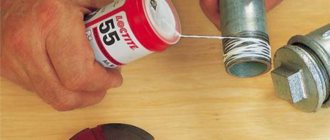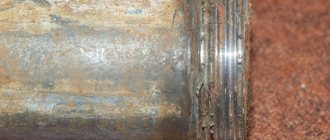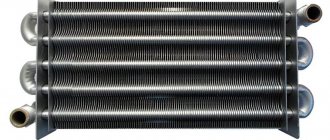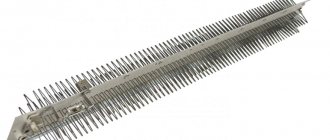Pipe winding, plumbing thread, sealing thread - all this is the name of one material. A threaded sealing thread is an elongated polymer fiber impregnated with a sealing compound. Each manufacturer has their own. For example, SPRINT thread is impregnated with silicone paste.
Sanitary thread is a modern and very convenient alternative to linen and fum tape.
Main types of pipe seals
From the entire arsenal, the following can be distinguished:
- Linen
- Adhesive sealant
- Silicone
- A thread
- FUM tape
The question “which pipe sealant is better and which is worse?” - incorrect. In order to understand this question, it needs to be posed somewhat differently: “What type of sealing of threaded connections should be used in specific conditions?”
Let's start with what sealant should not be used for threaded connections:
- Silicone (good for flange connections);
- Ship's red lead;
- Whitewash, various types of paints.
So, there are 4 types of material left:
- Linen;
- Thread;
- Adhesive sealant;
- FUM tape.
How to wind flax on a thread
Hello dear homemade people.
Until now, the best winding for thread is linen. First, I will justify this statement, and then we will analyze the execution process piece by piece.
The first alternative to flax is fum tape. There are at least three reasons why it should be abandoned.
1. It is unknown who made it, despite what is indicated on the label, which means there are no guarantees of quality.
2. It takes a long time to wind it.
3. When tightening the thread, especially when installing valves, it is impossible to correct its position, that is, you can only tighten it forward. If you push it back a little, the connection on the gun will leak.
The second alternative is a Tangit unilock pipe with a lock. I won’t argue about the lock - it’s dead, but as for the key: consider that they screwed it up and threw the key away, so you can’t find it.
You can't unscrew it, you can only cut it.
Linen is a completely different matter.
Seal flax
Flax for winding threaded connections
You can use flax as a winding for pipes on all metal parts: brass, cast iron, steel. With limitations, flax can be used where metal threads are soldered into plastic threads. A bad option would be to use linen on completely plastic parts. When sealing threaded connections where the sealant is flax, a large tightening torque is required. This moment can sometimes exceed the capabilities of plastic parts, which is why it is possible to break the thread itself.
Varieties, alternatives and selection rules
Flax is good for laying almost all metal pipes, including cast iron, stainless steel, non-ferrous metals, including copper, and their alloys, such as brass. The only exceptions are aluminum and metal-plastic products, as well as those made from polymer compositions. For them, professionals recommend using fum tape.
Fibers of various qualities are available on sale. All of them are produced on the same equipment - a carding machine. They are distinguished by numbers, which contain a description on the label. They vary in the range from 8 to 24. In this case, fibers with a higher number will have fewer impurities and vice versa. They are also characterized by a degree of flexibility, which is less important in their work.
Fibers are packaged in coils, as well as braids of fixed weight and size. Their color can vary from white to light gray, as well as beige due to the use of natural raw materials.
Plumbing thread
Sealing threads with plumbing thread
Plumbing thread is an excellent winding material for pipes with one drawback: its high price. It cannot be torn by hand and is suitable for sealing all threaded joints (even those that have a torn surface from a bad thread cutting tool). As for plastic parts, the tightening torque required when using threads is not the same as when using flax. Plumbing thread can be used for all parts.
Pros and cons of using
The main advantage of choosing tape is its availability. FUM is sold at a low price, cheaper than flax tow and most other sealants used in plumbing.
The material is characterized by ease of installation. With proper skill, winding the tape occurs in a matter of seconds, but for this you should practice winding it on connections of different diameters for some time.
An important advantage of using tape is that the parts fastened with it can be easily disassembled. The connections do not freeze tightly; they can be disassembled even years after installation.
The main disadvantage of the material is that it is not the most reliable of seals, therefore, as a rule, it is not used for industrial installation. However, for household repairs the hermetic properties of FUM are quite sufficient.
Another disadvantage is that the tape often protrudes outward from the joints, so the pipes may look sloppy because of this.
Tape on thread Source sdelairukami.ru
Anaerobic sealant
Anaerobic sealant
Anaerobic sealant is certainly suitable for sealing all plastic threaded connections, for brass, for cast iron, factory-made, but there is one peculiarity on steel parts.
When threads are made in a steel part, various types of lubricants are used that get onto the threads. When applying glue, once it hits a greasy area, it lingers there. This may not be noticed. Once the coupling begins to be turned, a channel may form through which the liquid will then flow out.
It is not always possible on site to remove grease from the surface of the thread. Therefore, it is not recommended to use glue-sealant as a sealant for steel threads and parts, since there is flax and thread.
When using sealant, pay attention to what kind of adhesive sealant you got. Some grades require heating when disassembling the joint. Imagine a metal connection with a metal coupling followed by a plastic pipe. To disassemble it, you must first heat it up (obviously more than 100 degrees). For the metal part this does not matter, but the plastic pipe may later be damaged. Therefore, look at what type of threaded connections you seal with sealant!
Rewinding consumption
- DN 15. 5-8 turns required (35-55 cm) - DN 20. 7-10 turns required (60-85 cm) - DN 25. 8-12 turns required (80-125 cm) - DN 30. 9 required -15 turns (120-200 cm)
Establishing a connection takes about 1 minute. The same amount will be required to clean the thread if the thread comes out a little when twisting. This is not difficult to do - you just need to trim the protruding threads and remove traces of paste. By the way, the paste, unlike the impregnation of flax, is removed with one movement of a napkin. The connection is neat and clean, as is the work area around it. There is no hair, like flax, that flies and settles in all directions.
How to seal a joint with flax?
When sealing threaded connections, you need to be very careful. Accuracy is the key to ensuring that nothing leaks. When working, you will need a special paste, which you cannot do without. It can be applied to the thread immediately or to already wound flax.
Paste gets your hands dirty. It's not very pleasant to wipe them off. Therefore, there is a life hack - the installer first sits down, winds flax onto a threaded connection, checks the quality of the winding (everything should be smooth) and then uses the paste, making a dozen connections at once. The connection must be free of protruding hairs, the first two turns remain free so that you can safely screw the coupling onto the external thread. And towards the end of the thread a roller or thickening is formed.
All compaction occurs on the last two threads. They are not completely cut through, smaller than the other turns. They are sealed by gluing the sealing material between the two parts.
Areas and tactics of application
Plumbing thread is a truly versatile material. Suitable for use in the following systems:
- Water supply - hot and cold;
- Drinking water;
- Heating;
- Gas supply.
The following types of work are performed using thread:
- Assembly of internal and external systems;
- Replacement of taps and fittings;
- Replacing gaskets;
- Quickly twist multiple fittings together in preparation for system assembly.
Conditions for using a sealing thread (using the example of SPRINT thread
- Operating temperature range from -60 to +120 °C;
- Installation temperature - no restrictions.
The thread is suitable for sealing all types of threads: thin and thick, new and worn, clean and dirty, dry and wet, plastic and metal. The condition and type of thread are unimportant for several reasons.
Firstly, the thread itself consists of 280 polymer microfilaments. They evenly fill the thread gap, close all cracks and other thread defects and ensure reliable sealing of the seal, regardless of the quality of the parts.
Secondly, the impregnation of the thread contains a water-repellent component, which protects the thread from corrosion and ensures the sealing function even in a humid environment.
However, the tactics for winding the thread depend on the type and condition of the thread.
There are two ways to wind thread, which do not contradict, but complement each other.
The first way is criss-cross. It is relevant if you buy SPRINT plumbing thread. This is the method we, as manufacturers, recommend for assembling metal and plastic connections.
- Fasten the first turn with an overlap at the beginning of the thread.
- Wind the threads crosswise as you go.
- Make as many turns as indicated on the package.
- Twist the connection.
The second method is traditional and is more suitable for worn, thin and heavily soiled threads. We do not recommend this method of winding, but many craftsmen successfully use it. Here you no longer need to wind crosswise, but lay the thread in each turn. At the same time, make the winding thicker in the middle of the thread than at the edges. As a result, the thread should be completely hidden under the thread, and a bump will form in the middle.
Practice or instructions on the package will tell you how many turns to make. If the manufacturer, as in the case of Record threads, specifies the number of threads for different thread diameters, follow these recommendations. To calm down, you can make 2-3 more turns.
How to apply adhesive sealant?
It is impossible to apply sealant to many joints at once, as with flax. The glue is applied to the thread immediately before the “sausage” connection, which is then well spread over the entire thread. This is necessary to prevent empty spaces from appearing through which water can then seep through.
The threads should be checked after sealing the connection. Therefore, sealant is used quite rarely, in the most necessary cases. For example, when you need to connect a plastic part with a metal one, you can’t think of anything better than glue.
The manufacturer recommends applying sealant to only one part, but experience says otherwise. If you are sealing a threaded connection that will be difficult to get to, then apply the glue well with your finger to the coupling and threads so that there are no unpainted areas anywhere. It has a blue or red color, it is clearly visible. It is necessary that all the streams are filled and then the parts can be connected. For steel parts, it is better not to use glue as a sealant for pipes.
Pipe winding, plumbing thread, sealing thread - all these are names for the same material. Thread sealing thread is a stretched polymer fiber that is impregnated with a sealing compound. Each manufacturer has its own. For example, SPRINT thread is impregnated with silicone paste.
Sanitary thread is a modern and very convenient alternative to flax and fum tape. We'll talk about why it's easier to use thread and how to do it correctly in the 4th issue of the Guide. Let us remember that in the first three we talked about FUM, anaerobic sealants and sealing threads with flax.
Why is thread needed?
A reasonable question. Why do you need thread if flax tow and FUM spools are seriously established on the shelves of construction stores? But we know that demand creates supply. The consumer, who is used to doing everything in the house with his own hands, has long been looking for a sealant that would be simple and clear to work with. Without long practice and unpredictable results. And he got it. A sealing thread in a convenient package - which also plays a role, not only the content is important, but also the form - has become an alternative to traditional tools.
Plumbing thread is suitable for both emergency and routine household repairs. If the connection leaks, it can be quickly disassembled and reassembled with the thread. It gives results instantly, i.e. no need to wait for the composition to dry and set. And the winding procedure itself takes about 2 minutes, instead of 5-6 minutes with flax and fum tape.
We have already said that even a home craftsman should have all possible sealants in stock. But first of all, the thread. This is a universal tool for combating leaks and for performing a variety of small household jobs. We’ll talk about the unusual use of thread a little later, but now about its main purpose.
Areas and tactics of application
Plumbing thread is a truly versatile material. Suitable for use in the following systems:
- Water supply - hot and cold
- Drinking water
- Heating
- Gas supply
The following types of work are performed using thread:
- Assembly of internal and external systems
- Replacement of taps and fittings
- Replacing gaskets
- Quickly twist multiple fittings together in preparation for system assembly
Conditions for using sealing thread (using the example of SPRINT thread)
- Operating temperature range from -60 to +120°C.
- Installation temperature - no restrictions
The thread is suitable for sealing all types of threads: thin and thick, new and worn, clean and dirty, dry and wet, plastic and metal. The condition and type of thread are unimportant for several reasons.
Firstly, the thread itself consists of 280 polymer microfilaments. They evenly fill the thread gap, close all cracks and other thread defects and ensure reliable sealing of the seal, regardless of the quality of the parts.
Secondly, the impregnation of the thread contains a water-repellent component, which protects the thread from corrosion and ensures the sealing function even in a humid environment.
However, the tactics for winding the thread depend on the type and condition of the thread.
There are two ways to wind thread, which do not contradict, but complement each other.
The first way is criss-cross. It is relevant if you buy SPRINT plumbing thread. This is the method we, as manufacturers, recommend for assembling metal and plastic connections.
- Fasten the first turn with an overlap at the beginning of the thread.
- Wind the threads crosswise as you go.
- Make as many turns as indicated on the package.
- Twist the connection.
The second method is traditional and is more suitable for worn, thin and heavily soiled threads. We do not recommend this winding method, but many craftsmen use it successfully. Here you no longer need to wind it crosswise, but lay the thread in each turn. At the same time, in the middle of the thread, make the winding thicker than along the edges. As a result, the thread should be completely hidden under the thread, and a tubercle will form in the middle.
Practice or instructions on the package will tell you how many turns to make. If the manufacturer, as in the case of Record thread, indicated the number of turns for different thread diameters, follow these recommendations. You can do 2-3 additional turns to calm down.
Reeling consumption The record for assembling steel pipes looks like this:
– DN 15. Required 5-8 turns (35-55 cm) – DN 20. Required 7-10 turns (60-85 cm) – DN 25. Required 8-12 turns (80-125 cm) – DN 30. Required 9-15 turns (120-200 cm)
Assembling the connection takes about 1 minute. The same amount will be needed to clean the thread if the thread comes out a little when twisting. This is easy to do - you just need to trim the protruding thread and remove traces of paste. By the way, the paste, unlike flax impregnation, can be removed with one movement of a napkin. The connection is neat and clean. As is the workplace around it. No “hair” like flax that flies and settles on all surfaces.
Bottom line: benefits of sealing thread
- Fast twist and instant results.
- Independence - the thread is completely ready for use, you do not have to buy additional materials in the form of impregnation. Saving your money is also obvious here.
- Safety - does not contain toxic substances harmful to the respiratory system, eyesight and skin
- Versatility - suitable for any carving, including smooth ones.
- Convenience - the thread is packaged in a compact box of bright color, which is easy to find among the tools. Inside the box, the thread does not dry out for 5 years, and thanks to the spool, it does not get tangled. There is thread with replaceable spools, for example, Sprint plumbing thread. If the thread is used up - and this always happens at the most inopportune moment - you just need to take a new spool and put it in the same box. Instead of running to the store in the middle of the night. The thread in the box is sold with one replaceable spool, and for further use it is enough to buy a package of replaceable blocks - 3 pieces of 50 meters each.
- Resistance to vibrations, shocks, temperature changes. The connection on the plumbing thread is not afraid of the constant expansions and contractions characteristic of plumbing and heating systems. These deformations are not harmful to the connection.
- Possibility of adjustment. Once the threads are sealed, the connection can be adjusted up to 180° without loss of seal.
Unusual use of thread
As promised, we tell you how unusual, but always useful, to use plumbing thread at home.
- If you have musical instruments, use string to strengthen any flimsy parts. Another option is to repair the straplock of an electric guitar. A resourceful craftsman fixed a loose guitar strap mount.
- For selfie lovers, the thread will be useful if you need to fix your phone holder (aka selfie stick).
- Thread can also be useful outside the home. Here is an interesting experience in assembling a distiller in a chemical laboratory using pipe winding.
- And here is the experience of replacing the rubber gasket during repair of the drain tank.
If you are now looking for a universal seal that can be useful not only in the bathroom and kitchen, but also in any other part of the house for solving small household problems, take thread. It will help you out while you are waiting for a plumber, it will come in handy in your garden, and one day it will help you in the most unexpected situation. So be prepared.
Using FUM for a gas pipeline
To fasten gas pipeline parts and install gas equipment, you should use only special FUM tape for gas. It must be supplied with a certificate of conformity confirming its suitability for use on gas pipes.
The special film for gas is yellow. It is made wider - up to two centimeters in width.
Yellow FUM tape for gas Source megastroy.com
The use of the material is possible only when sealing can only be achieved using a sealant. In the case of rubber hoses, as well as metal hoses, the sealing function is provided by a special gasket. In this case, the additional seal will not add tightness to the connection, and may even break it, as it will interfere with the tight fit of the gasket.
Briefly about the main thing
FUM tape is one of the popular and effective sealing options. It is affordable, easy to use, and does not create problems during subsequent repairs.
There are several simple rules on how to wind FUM tape onto a thread:
- the winding area must be cleaned;
- the tape is wound along the thread - how the nut will move along it;
- When winding the tape, you need to tighten it a little;
- Usually four layers are enough, but sometimes more are required;
- After winding the tape, the thread relief should be palpable.
Things to consider
When working with tape, it is necessary to take into account some of its characteristic features.
- The tape is quite slippery, so you need to wind it carefully so that the strips do not move out of bounds. It is advisable not to allow the edge to fall out into the inside of the connection.
How the tape should be positioned on the thread Source abro-ind.ru
- Once the film has already been wound, it cannot be unwound and re-wound - this will break the tightness. Try to process it carefully right away, otherwise you will end up wasting a lot of material.
- Also, the tightness will be broken if there is a need to loosen the connection. In this case, you will also have to rewind the material.











